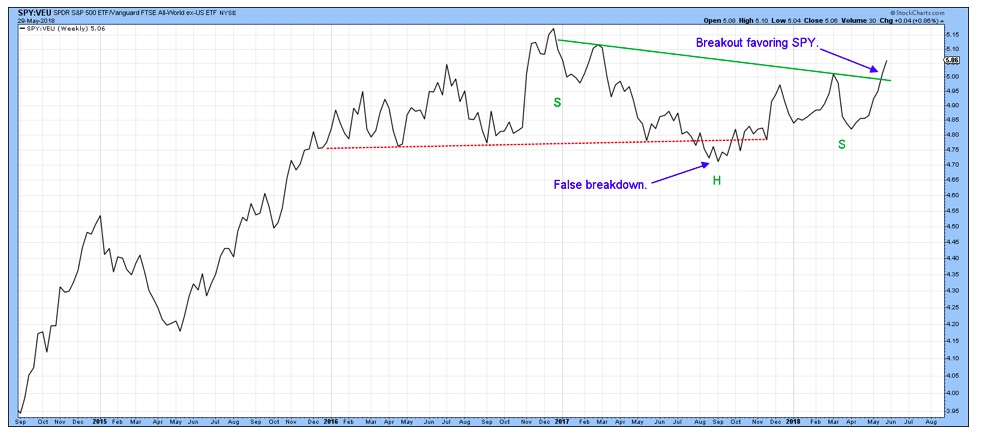Weekly Wrap: Only a Little Left in This Expansion
With the Memorial Day holiday, there were just four trading days this week and what a ride they were. Tuesday began with an Italian political crisis as the coalition between Italy’s far-left Five Star Movement and far-right League fell apart. The yield on the Italian 2-year bond rose all the way from (-0.1%) on May 12th to over +2.8% during the kerfuffle, but by Friday had dropped back to just over 1.04%.
To be fair, given that Italy has had 68 governments since the end of World War II with an average duration of less than 15 months, the phrase Italian political crisis is arguably redundant. Tuesday the nation was without a Prime Minister and set to return to the polls, but by Friday morning the odd couple coalition had mended fences with one another and along with the President of the Republic, had restored the on again off again Prime Minister Conte and even agreed upon an Economic Minister – the role that had begun the entire drama.
With Italy having the third largest economy in the eurozone and eighth largest in the world alongside the second largest debt to GDP ratio, (bested only by Japan) its drama, filled with anti-euro sentiment, has the potential for far-reaching impact. Those involved may have temporarily kissed and made-up, but the economy and its political system is still a mess with no clear path to successful reform. This drama is on the backburner for now but is far from over.
By Tuesday’s close, stocks around the world had sold off sharply and the AMEX Dollar Index had risen over 7% from its mid-February lows as investors pulled away from risk assets. The euro fell to its lowest level in 10 months and the yield on the 10-year Treasury, having risen as high as 3.12% on May 17th fell to as low as 2.76% during Tuesday’s trading and closed Thursday at 2.88%, surprising the hell out of many of those bond bears who had loudly proclaimed that once the yield broke 3%, it would never look back.
The concerns in Europe and the impact of the rising dollar on emerging markets has led to the return of US equity outperformance versus the rest of the world, as can be seen on the chart below, (hat tip to Martin Pring) which shows the relative performance of the SPDR S&P 500 ETF (SPY) to the Vangard FTSE All-World ex-US ETF (VEU).

This week the Dow Jones Industrial Average bounced off its 50-day moving average after having dropped to a three-week low on Tuesday. Financial stocks in the US were hit harder than most all other sectors on Tuesday, primarily due to contagion fears from eurozone banks. The Financial SPDR ETF (XLF) tested support along its 200-day moving average but managed to remain above its 50-day.
Wednesday the markets saw strong recoveries with a modest pullback again on Thursday while Friday opened up strong again thanks to a stronger than expected jobs report and recovering European stocks. That being said, the number of stocks in the S&P 500 making new highs has not gone above 50 (10%) since mid-March, reflecting a lack of leadership. On the other end of the spectrum, with the strengthening dollar, the S&P Small-Cap 600 has had more than 60 (10%) new highs several times this month. Technology stocks also fared better in this week’s rousting with the Nasdaq 100 ETF (QQQ) remaining in its overall uptrend.
Things outside the US aren’t looking so great, which is likely to keep US equities outperforming as we are seeing capacity utilization rates in Asia rolling over along with slowing export growth. Emerging market equities are down around 10% as the dollar continues to strengthen, which is increasing the burden on a region with an $11 trillion debt overhang, nearly twice the $5 trillion load in 2011.
On the US economic front, GDP for the first quarter was revised down slightly to 2.2% from 2.3% with consumption at just 1.0% versus 1.1% but non-residential investment strengthened to 9.2% from 6.1%. To the north, Canada’s first quarter GDP came in at just +1.3% versus expectations for 1.8% and the prior quarter’s 1.7%. Thursday’s US personal income report was mostly in-line with expectation, up 0.3% in April, but March saw a downward revision to 0.2% from 0.3%.
The big news for the week came with Friday’s job report which saw the headline payroll number hit 223k, well above the expected 190k. There was also an upward revision of 15k to the prior two months. Even retailers added 31k to their ranks, despite the headwinds facing our Cash-Strapped Consumer with a savings rate of just 2.8%, near the lowest on record.
The headline U3 unemployment rate declined to 3.76% from 3.93%. The last time the unemployment rate was this low was in December 1969, with a recession just starting. While we love to see people getting jobs, a rate this low means there is little left in this expansion. We are today fractionally below the Fed’s forecasted 3.8% unemployment rate for the end of 2018 and well below its estimate for a sustainable unemployment rate at 4.5%. On top of that, the core Personal Consumption Expenditure index is up 2.3% year-to-date, which is well above the Fed’s 2% target.
The Fed is going to have to raise rates at the next meeting and the likelihood of more rate hikes than the market is expecting continues to increase. Average hourly earnings rose more than expected at 0.3% month-over-month to push the annualized rate to 2.7% from 2.6%. From a historical norms perspective, this is still pretty weak, but for this expansion, that is really heating up. For the over 80% of the economy in the nonsupervisory production category, the annualized rate has increased to 2.8% from 2.6% with the annualized three-month rate up to 3.6%. Ladies and gentlemen, we have wage growth! Businesses will be facing margin pressure from both rising labor costs and high borrowing costs as the Fed continues is hikes.
The bottom line for the week is that we have near record low unemployment and savings rate, so just where is the accelerating spending going to come from as businesses face shrinking margins with such a tight labor market? The increase in wages isn’t going to be sufficient with rising prices, particularly as more tariffs are likely to add to higher prices. Something to think about.
Next week we’ll be looking out for the JOLTS report to get more insight into the labor market, the ISM Non-Manufacturing Index and with such a low savings rate, we’ll be paying particular attention to the report on Consumer Credit on the 7th. Have a great week!

